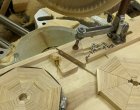What type glue do most segmenters use?
I haven’t fallen into the segmenting vortex because of an aversion to end grain joints from flat work. But have been doing a lot of pieced work where I glue up side grain to side grain. I really like the arcs that are exposed when turning bowls, and interesting patterns that can be achieved in bowls and platters with different woods.
With that background, I have a question about glues. Most all of my glue ups have used Titebond3. I’m very happy with this except then gluing two light colored woods together, or when a light color wood is toward the bottom of a bowl where the glue joint is cut at a very shallow angle. In both those cases the glue joint shows more than I’d like.
I just ordered a gallon of Titebond2 Extend because of it’s translucent color and still some water resistance. I usually finish with Watco and then buff/wax. Most of my bowls are candy bowl size, and probably won’t hold liquids for extended periods but I still want them to be durable. I think T2 will be fine, but curious about others experience (after I’ve already purchased...).
Thanks
I haven’t fallen into the segmenting vortex because of an aversion to end grain joints from flat work. But have been doing a lot of pieced work where I glue up side grain to side grain. I really like the arcs that are exposed when turning bowls, and interesting patterns that can be achieved in bowls and platters with different woods.
With that background, I have a question about glues. Most all of my glue ups have used Titebond3. I’m very happy with this except then gluing two light colored woods together, or when a light color wood is toward the bottom of a bowl where the glue joint is cut at a very shallow angle. In both those cases the glue joint shows more than I’d like.
I just ordered a gallon of Titebond2 Extend because of it’s translucent color and still some water resistance. I usually finish with Watco and then buff/wax. Most of my bowls are candy bowl size, and probably won’t hold liquids for extended periods but I still want them to be durable. I think T2 will be fine, but curious about others experience (after I’ve already purchased...).
Thanks

